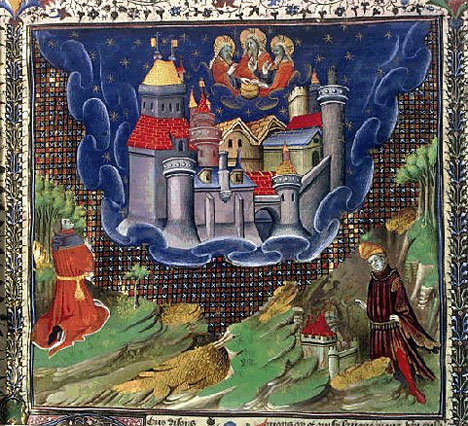Seven Mountains
“But now they desire a better, that is, a heavenly country. Therefore God is not ashamed to be called their God, for He has prepared a city for them.” (Hebrews 11:16)
The narrative of the Bible is fairly linear until we get to the kings. But once we hit the prophets the Scriptures turn into a box of puzzle pieces. The literature of the kings used Mosaic symbols to a certain degree but the prophets took all the concrete things we learned from the priests and kings and used them to make amazing promises that never quite materialized. Or did they?
 One of the mysteries is the idea of the mountain of God. For everyone living before AD70, the promises were expected to be fulfilled upon the physical real estate of Mount Zion. God had appeared upon various mountains throughout history (which made Him unlike all other gods because He was not stuck to a particular territory) but for over a millennium His house had been in Jerusalem. When the Temple was destroyed by Roman armies and the entire landscape so defaced that we are still studying the “dental records,” the promises concerning the mountain seemed to evaporate. Did these promises become mere ideology? If they were not physical in nature, how are we to understand them?
One of the mysteries is the idea of the mountain of God. For everyone living before AD70, the promises were expected to be fulfilled upon the physical real estate of Mount Zion. God had appeared upon various mountains throughout history (which made Him unlike all other gods because He was not stuck to a particular territory) but for over a millennium His house had been in Jerusalem. When the Temple was destroyed by Roman armies and the entire landscape so defaced that we are still studying the “dental records,” the promises concerning the mountain seemed to evaporate. Did these promises become mere ideology? If they were not physical in nature, how are we to understand them?
As always, the many details given through the Bible appear to be random dots. But in hindsight, we are able to join them. The “seven mountains” in Bible history follow a pattern that is well-known around here. The seven points form a process of maturity which is Creational, Covenantal and also sacrificial. And once we trace the pattern, which happens to be a chiasm, some very interesting points begin to rise out of the clouds. The internal logic of the “mountain theme” becomes plain and we get the prophets as clearly as the writer of Hebrews did.
Creation: Eden – The initial triune world enjoyed the direct presence of God (Day 1 – Genesis)
Division: Ararat – A “covered” three level “world substitute” passes through the waters (Day 2 – Exodus)
Ascension: Moriah – Abraham offers Isaac, his firstborn, as an “ascension” (nearbringing) for the Promised Land and its people (Day 3 – Leviticus)
Conquest: Olivet > Heaven – As foretold by the prophets, Christ mediates from the true mountain of God, the Most Holy. The Old Covenant saints rule with Him in their inheritance (Day 6 – Joshua)
Glorification: Shekinah – Finally, the kingdom mountain has grown to fill the entire world, which is indwelt by God, heaven and earth united as a single “cloud,” the completed Tabernacle (Day 7 – Judges)
While there are seven in the complete pattern, the central three (as a three-cubed grid) illustrate Israel’s role in the ethical transformation of the world. On Israel’s first mountain the father offered the son —- the Most Holy. On her second mountain, the cloud appeared with blood, fire, smoke and trumpets — the Holy Place. Israel’s third mountain of God was Zion, into whose Temple the nations willingly brought their treasures.
What is interesting is that Moriah and Zion correspond chiastically, as the bloody Bronze Altar (Adam) and the fragrant Incense Altar (Eve). Zion was actually a different mountain in Judah until David’s purchase of the threshing floor for the site of a Temple. Moriah received “a new name.” Moriah (death) and Zion (resurrection) became one and the same. This also explains the strange reference to “1000 years” in Revelation 20. God mediated through “tent worship” for 1000 years, beginning with the offering of Isaac. Then He mediated through “house worship” for 1000 years, ending in AD70. The current administration from the heavenly mountain is thus for “1000 years.”
At Christ’s ascension, the role of Adam as the representative of the Physical world before God was finally fulfilled. He is the first five mountains, the Torah, combined into a single “fivefold” Old Covenant inheritance. Zion was the last “earthly” mountain and it ascended as sacrificial smoke. Jesus now advocates for the world until heaven (God owns…) and earth (…a thousand hills) are one (Psalm 50:10), just as Adam should have done.
ADDENDUM:
After some comments from friends (including Chris W. below) it needs to be stated that Jesus’ focus on the Mount of Olives pictured the true mountain of God in heaven. Christ ascended from it, yet the earthly version would be “torn in two” on the final “Day of Atonement,” divided between the blessed and the cursed, as predicted by Zechariah. The earthly mountain was opened like the veil to allow the Old Covenant saints to pass through into their heavenly country, just as Israel passed between Ebal and Gerizim into Canaan.
Also, Mount Carmel, which seems to be left out of the pattern, was a prophetic reminder of Sinai, a legal witness to the prophets of Baal.
If anyone has anything else to add, please feel free to comment!



























August 8th, 2013 at 10:59 pm
Fantastic! The first six mountains also tie themselves neatly to the six major covenants in history. Would you see the Mount of Olives as a picture of the heavenly mountain as well?
August 8th, 2013 at 11:08 pm
Great point – yep. I guess it’s the launch pad! It got “split in two” after all, as Ebal and Gerizim, (and like the Altar), to let those fragrant saints into their heavenly inheritance.
August 8th, 2013 at 11:21 pm
At step 6, Olivet would be the Most Holy earthly mountain, the place of Atonement, healing by the oil of the Spirit.